iRun Radio
On this week show, Mark speaks with a runner who had a tough but rewarding run at the Tokyo marathon. Then a woman running New York City Marathon in memory of her mother, and Ray Zahab shares the details on his latest adventure.
On this week show, Mark speaks with a runner who had a tough but rewarding run at the Tokyo marathon. Then a woman running New York City Marathon in memory of her mother, and Ray Zahab shares the details on his latest adventure.
As much as running changes you, as every parent knows having a child changes you for life. After nearly a year as a new mom Melissa Bishop reflects on why she runs, how the sport has changed for her as a parent and what running gives her as a mom.
iRun: Who or what inspires you to run?
Melissa Bishop: This answer was different a year ago. Now that Corinne is here and a large part of my life she has been a huge inspiration in getting me back into running at this level. Although there are days when it’s really hard to leave her at home, knowing what I’m chasing after, being able to show her what hard work, physical activity and moving looks like has been so inspiring to me.
iRun: Why do you think more people should give the sport a try?
Melissa Bishop: For me running is a great stress reliever. It’s the time to think. No matter how bad of mood I’m in before a run, after a run I always feel better! Running can release such great endorphins. Plus, if you own a pair of running shoes, you can run—no membership required!
iRun: How has running changed for you as a parent?
Melissa Bishop: The only way running has changed for me as a parent is the timing of it. Before my daughter, I could go whenever I wanted. Now as a parent my runs and workouts are timed around her naptime. It may sound odd, but I don’t run with Corinne all that much. My workouts are my work, which mean that each run needs to be quality and my form needs to be perfect. Running with a stroller makes that difficult. It would be like take-your-kid-to-work-day, every day. That said, my husband, Osi, and I frequently run together. So we will pack her up in the stroller and head out the door. And if not with me, he and Corinne go for a run 6 days a week at least.

iRun: Is there a different meaning for you now when it comes to training?
Melissa Bishop: Having children puts life into perspective. I know any parent or caregiver reading this will understand that. Training is still and always have the same meaning for me what has changed is my separation with it. I used to take the bad days home with me—we all have them—but now I leave those at the track. Now, my life is different when I come home I’m a mom and there’s a sweet baby waiting for me when I’m done.
iRun: Where will running take you in the next year?
Melissa Bishop: I have many goals in the next 12 months—I’m back into full time training and have expectations. World Championships are coming up in Doha, and most importantly, Tokyo 2020 next August. There are a lot of races and opportunities in the next 12 months—we’re taking it all one day at time.
Global Running Day, for us, really, is every day. However, with all eyes on runners for 24 hours, it seemed only right to highlight some of our heroes of the sport. We asked readers and Olympians, people all over the country, to tell us who they admire in the running game. This is just a snapshot of what makes running so great. It’s the exercise, the motion, the runner’s high, sure; the racing, the goals, the fancy shoes. But really, when you boil everything down and take what we love to its essence: it’s the people, the community. Here are a few stories by a few authors of runners we love. Happy Global Running Day, be kind to a runner you love.
Lynn Kanuka, by Natasha Wodak

Coach Lynn is positive, motivating, and dedicated. I’ve run for a long time and think her and I work so well together because she’s done all this running stuff herself. She knows exactly how I feel — cause she’s done it all! On my good races, she says “Tash, you were so awesome out there!” On my bad ones, she says “you were tough out there & you did your best.” And when I won the Ottawa 10K (finally!), she said “TASH! You did it!” Then a big hug cause she was there:) Lynn herself is an extraordinary runner. She ran 4:00.27 in the 1500m in 1989, which is still the Canadian record!
Nathan Brannen, by Cam Levins
His career inspires me. His ups and downs, and returns from injury are so impressive; it’s something I didn’t truly respect and understand until experiencing difficulties myself. Especially I think of his fight back from surgery in the fall of 2007 to ultimately qualify for the Olympic team the following year. I admire both the discipline and determination it took to recover from every setback, and always be competitive regardless. It takes a great love of the sport to continue running and racing hard despite adversity, and I think few displayed this better than he did. His story is a reminder of the things that are worth it are rarely easy, but never regretted.
Caster Semenya, by Justin Lagat
She is natural. She isn’t going to accept to use drugs for IAAF to accept her race in her favourite distances ranging from 400m to 1500m.
She is bold. She isn’t affected by what others think about her. She runs confidently with her head held high despite everything and doesn’t show any signs of seeking sympathy from others.
She is flexible. She already has other plans for her career after running. She does not quit. She won’t. No one can stop her. Ever.
She fights for what she believes in. Even while pursuing other options to remain running competitively, she was able to go to court to appeal the decision by the IAAF to prevent her from competing. She continues to do so.
She is quiet and lets her legs do the talking. She is not known to talk very much about her impressive runs and plans to run fast times ahead of her races, but she goes ahead and beats every competitor in her races.
So much so, that they tried —and failed—to change the rules.
Terry Fox, by Colleen Berry
Terry Fox is an icon. His legacy is kept alive in celebration of his Marathon of Hope on the third Sunday in September with the Terry Fox run. This generous and selfless young man had a dream to contribute to the possibility of ending cancer. He was a pioneer of many things, especially the concept of endurance running for charity. This took much planning, but he was frugal—and resourceful. His ambition had little support or awareness in its beginnings. However, as the mileage logged from the journey which commenced in St. John’s Newfoundland, it picked up interest by the time it reached Ontario. Unfortunately, its notoriety and enthusiasm was just picking up steam when Terry hit a major road block beyond his control—cancer—but he had faith that others would continue his dream.
It is up to us to continue to go the distance. A young man running with a prosthetic (crude compared to today’s equipment), covered a marathon distance each of his 143 days. The ironic thing about this is that Terry, though he unfortunately succumbed to cancer, has saved the lives of many. His example of concept, courage, incredible effort, and accomplishment are ways to live that spills over into many facets in our lives. Terry Fox was a real person and did everything within his ability to make a dream come true. It did, and it is up to us to carry it through.
Maya Anderson, by Sarah Hull

As a female runner, someone I’ve always looked up to is Maya Anderson. She is someone who took a dream and made it come true when she left the corporate world to open BlackToe Running with her husband Mike Anderson. As a passionate runner despite any setbacks she may face, Maya pushes through and continues to run with the BlackToe Race team, showing resilience and grace. Maya truly supports every member of the BlackToe Race team, being selfless, announcing birthdays and setting up epic cheer stations during races, almost always sacrificing racing herself. A good race or bad, you can always count on Maya for a post-race hug as she truly cares about each and everyone who runs.
Jean Paul Bedard, by Larry Dearlove
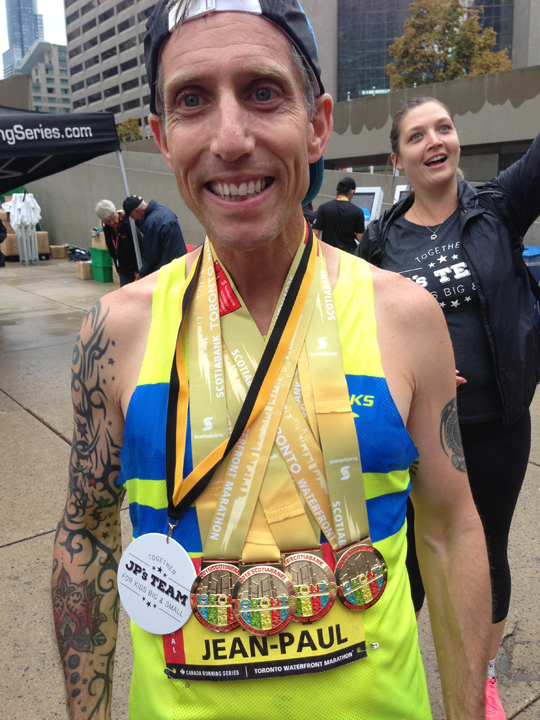
JP took a very bad experience (his childhood abuse) and did not let it define him, but instead used it as the driving force to help others who have suffered similar experiences. He has become a champion for many as he has used running as a way to inspire others. He has many outstanding running accomplishments, but as a fellow marathoner, I am still in awe of his running the STWM four times in one day.
Krista DuChene, by Kirsten Parker
There is something so personally inspiring to me about how committed she is to running her race at this moment in time. She is so present with maximizing the skills she has right now and not thinking about the past or things she can’t control.

We talk to three runners who had great outcomes in spring marathons: one runner who a year ago was recovering from injuries and a few weeks ago won the Mississauga Marathon. A runner who completed his first marathon, at age 60, after recovering from cancer treatment. And Krista Duchene, who struggled in Boston this year, who came back to have a great performance in Ottawa.
How you can take part in the global phenomenon that’s gotten 5-million people running around the world … for free!
On any given Saturday morning, in parks across the country, there’s a diverse group of people of all different abilities enjoying themselves while running 5K. It’s free, it’s fun, it’s inclusive, and if you participate, you can make friends from all over the globe.
Linda Newton, along with her husband Keith, can attest to all of these elements of the healthy weekly gathering. The leaders of the Kanata park run who were living in London, England when they discovered parkrun, says, “…my parkrun barcode is my passport to a community wherever I travel.” Organized by volunteers, and run with an emphasis on community engagement (runners are encouraged to join the group post-run for coffee), parkrun, which is sponsored by Saucony though has a decidedly non-corporate feel, is opening running to a diverse group of people. As volunteers for parkrun, Linda and Keith have experienced the rewards of this global phenomena—they travel with the friends they’ve made through the event gaining steam all over the world.
“We want to see everyone running, it doesn’t matter your abilities, and we get all sorts of people out every Saturday,” says Euan Bowman, the British-born, Vancouver-based country manager for parkrun Canada. “We can all benefit from a parkrun—from the exercise, from the camaraderie, from the fun. There are no strings attached.”
iRun recently attended a parkrun with Linda and Keith on race weekend in Ottawa and it was love at first run. There were parents pushing running strollers, kids having the time of their life and runners using the event as their shake-out run before their race.

Parkrun is free—always—and enrolment is done online. Each person brings their personal bar code to the event and it’s scanned at the finish to coincide with a token issued at the end of the run. It’s like an arcade for runners and adds to the novel outdoor experience in a beautiful environment, free of judgment, free of stress.
“We want to provide a parkrun to every community that wants one,” says Euan Bowman. “I don’t see why Canada can’t have 500 events.”
The total run time is synchronized with your check-in at the finish and the results are emailed to each participant. No need for timing mats or stop watches, as the timing can be done using a mobile phone on the event’s Virtual Volunteer app. Membership provides access to all parkrun events—regardless of your hometown. What’s more, there’s an all-call for volunteers to start new parkruns where they live. There’s no ceiling on how many people can participate. How many events can be held. How many lives can change.
“A parkrun will benefit any community and it’s a massively, hugely rewarding experience —addictive, some might say,” jokes Bowman, with a laugh. “Very few people, we’ve found, do just one. It’s like running in that way: when people just realize that it’s accepting and fun, why wouldn’t do something healthy with friends?”
A few more parkrun tidbits you need: volunteers ensure that the course is accurately marked and marshalled, and there’s a code, worldwide, of which the parkrun ascribes: no runner is left behind. (Each event has its own “tailwalker,” who picks up the rear).
In Kanata, where the course runs through the scenic Beaver Pond Trail, there was no shortage of wildlife and smiles. Some runners went hard, racing the course; some went easy, trying to stay limber for their event the next day, and some just went at their own pace, talking about how lucky there were to spend the morning with friends in the post-run meet up at a local cafe.
There are milestone shirts to mark the number of occasions a participant completes a parkrun. The colour-coded shirts to mark the occasion at fifty, one hundred, 250 and 500 events. Over the fifteen years of parkrun’s inception, there have been only a handful who wear the coveted dark blue 500th parkrun shirt.
Since the start in 2004 by founder Paul Sinton-Hewitt, there are over five million registered parkrun participants, who have logged a total distance of 237,255,688 kilometres in 1,863 parks with a grand total of running time worldwide of 2,828 years,177 days, 4 hours, 53 minutes and 5 seconds. Slightly shy of 10,000 participants in Canada, find the location closest to you at the 27 Parkrun locations, right here at home.
Do you have a story to share about your parkrun experience? Send a story, 400 words maximum with an image to Sabrina@irun.ca and be featured in our summer issue.
Parkrun is a good thing for running. Run a parkrun. Be in iRun.
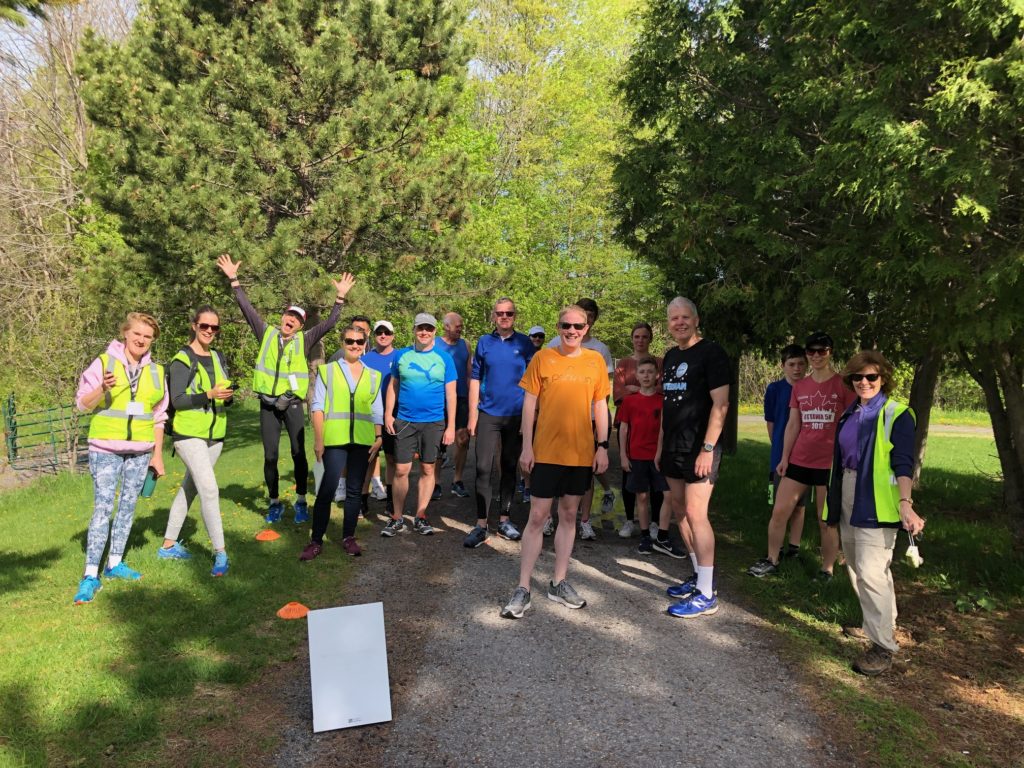

The inside of the Cabbagetown Boxing Club is exactly what you’d expect to see when you walk into a boxing gym. Walls are littered with vintage fight posters from Ali and Duran. Just outside the men’s change room is a tribute to Canadian heavyweight George Chuvalo.
It’s loud–the thud of the heavy bag punctuating all activity. A sound system that indicates various intervals and the end of a round of sparring has to be even louder so fighters in the ring can actually hear it. There’s a section for weight training and an open floor space where a few guys jump rope and work through warmup drills. One gentleman, bald and covered in tattoos, smiles and sings along to Bananarama’s “Cruel Summer” as he skips, which helps take the edge off the somewhat intimidating atmosphere.
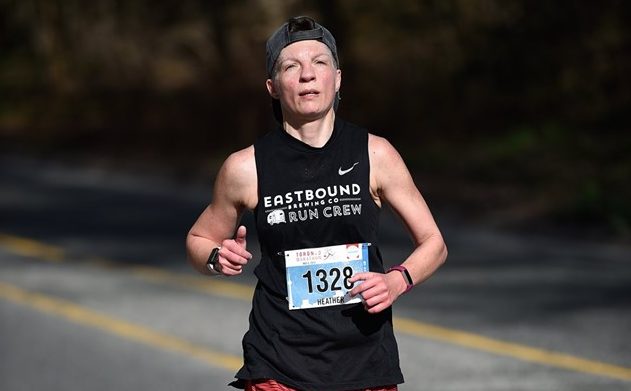
Heather Hopkins is one of the fighters pounding away at the heavy bag when I walk in. She’s been training at Cabbagetown for a decade now and has about 40 amateur fights under her belt. For the last few years, she’s also worn the hat of trainer. Once she’s taken her recruits through a final seven minutes of core work to end their session for the evening, we move to an office space at the back of the gym that was formerly used by a sports psychologist. Between our chairs is a duffel bag filled with boxing gloves.
It’s not the site I would have ever expected to interview a 15 time marathoner, but that’s what Heather is, balancing two passions informed by what she describes as her perpetual need to move. “I’m a work in progress,” Heather explains. “I’m always looking for a challenge and whatever new thing I find, I just want to be really good at it.”
Boxing came first. “I walked by a gym on Yonge Street, saw some guys hitting the bag, and I felt like I had to do that,” Heather says. From there it was a natural progression to competition. “The gym I was at wasn’t producing fighters and I was told that if I wanted to compete I had to go to Cabbagetown.”
At that point, Heather was in her late twenties. Cabbagetown trainer Johnny informed Heather that she was a bit old to be starting out and that Coach Pete Wylie needed at least three years to build a fighter. Heather assured them she was committed.
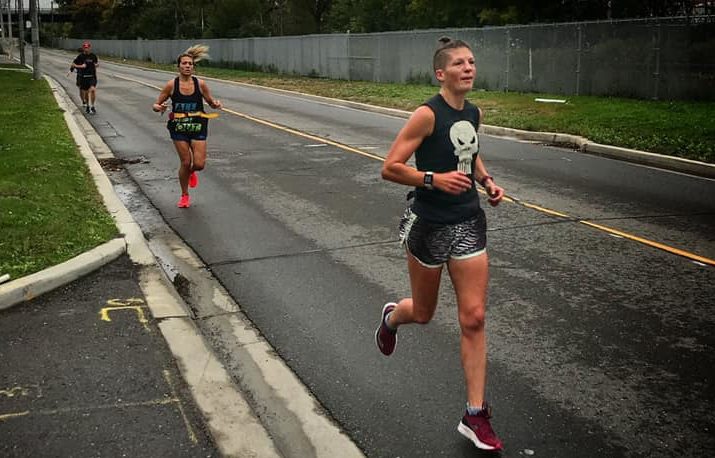
Fighters, of course, are required to do roadwork. No training montage is complete without a shot of a boxer trotting along in sweats and throwing jabs and straights at the imaginary opponent in front of them. “Coach Wylie needed me running about three or four times a week, but I hated the basic running program he gave me,” Heather says. “I just did it because I was told to and I always do my homework,” she adds with a laugh.
Much like her foray into the ring, it was the notion that she could compete and be the best that made Heather adopt running wholeheartedly. “At first, I’d see others running, but I didn’t consider myself one of them; I was just a fighter doing roadwork.”
Racing changed all of that.
During the Cabbagetown Festival, Heather was surprised to find herself first among the women in the “mini marathon,” which she describes as “really just a mad dash through the neighbourhood for a mile.” The race experience, which pulled her up to greater distances from the 10K to the marathon, is part of what made Heather feel like she actually belonged to this thing everyone called the running community.
“I think I really did get the runner’s high and gradually started to find things I enjoyed about running,” Heather says. Those things included “…exploring my own city the further I went. Without realizing it I began to enjoy it.”
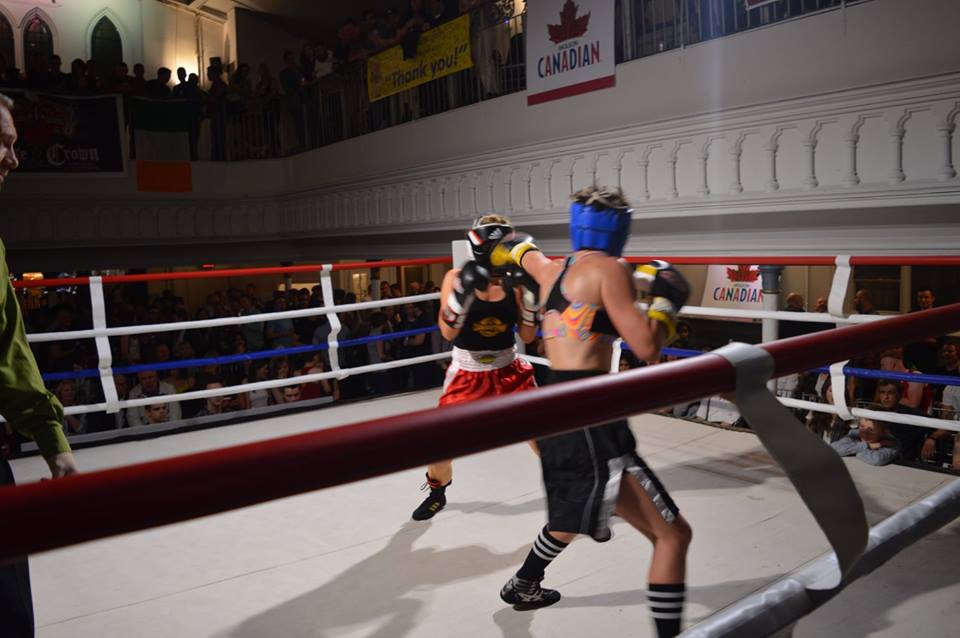
It’s now been 15 marathons for Heather, including a win at the Cornwall Marathon, her hometown race. It’s a remarkable achievement to excel at two very different athletic pursuits. While roadwork has always been a part of the fighter’s repertoire, marathon training is it’s own beast. Heather insists, however, that they complement each other well. “There’s a mental toughness required for both,” she explains. “When I’m running a long distance on a Sunday and trying to push through it I remember sparring sessions where I’ve had it tough and then you remember the fight you have in you. There is so much to fight against within and without.”
In practice, balancing the demanding training of two sports can be a bit more of a challenge. “I still don’t really work from a formal plan,” Heather confesses. Her marathon training is a hodge-podge of her roadwork, Sunday long runs with the Eastbound Run Crew, and daily run commutes from her day job to the gym. Six to ten rounds of sparring also registers as decent endurance training.
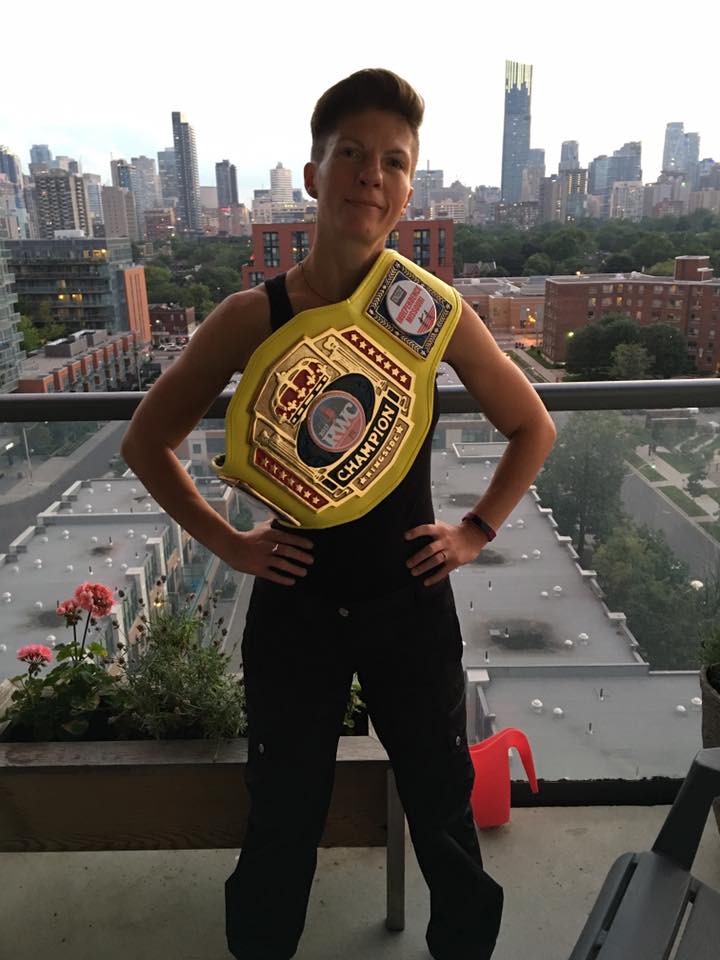
She’s managed to tack on some track work as of last year and even managed to enjoy it, commenting, “I thought it was the best. Whatever work you put in front of me, I’ll do it, so I loved having a track workout in front of me. The opportunity to run fast was something I liked.”
The approach is simple for Heather. She loves fighting and she’s come to love running. She also loves the work that both require, so there’s no sense in half-assing it. Neither was a bucket-list or “one and done” venture. The extreme competitiveness hasn’t faded altogether, but is balanced with that sense that she’s a work in progress. “That person may be faster than me on any given day or in any given moment,” Heather says, “but there are always things I can do in order to be better in another moment. I’m still working on being able to accept things I can’t control and be okay with it.”
“I feel comfortable calling myself a runner and am confident in that,” is how Heather describes her greatest area of improvement. “I feel that as a fighter and a runner, my opportunity is still there and I want to be involved in both in some capacity as long as I can be. If I can run forever, I will.”
Like her idol Anne Wolfe, who went from decorated amateur to professional fighter to elite trainer and even to actress, Heather is open to new ways in which she might challenge herself and feed her need for movement.
Follow Heather’s adventures at @hopalong.heather.
The connection between health and running is natural, but these runners have taken it to the next level. First, after multiple surgeries to correct a life long disability, Kelly-Ann Easy is running on new legs. Then, after having a heart attack at 31 years old, this mom talks about why she decided to run a half marathon at Ottawa Race Weekend. Plus, Dr. Singh, an Ottawa doctor, shares his thoughts on social responsibililty during a race as he’s running for medical research.

It seems appropriate to start this post from where I concluded my last, after my disappointing 2019 Boston Marathon, in which I said, “I’m looking forward to strolling along the streets of Boston tomorrow in search of some New England clam chowder and sweet treats before heading back home to pack school lunches and taxi kids to swimming and hockey. I have no race plans in place. I’ll chat with Coach Dave-Scott Thomas when I’m ready. For now, it’s all about grace and gratitude.”
I’ve never raced a marathon with a back-up marathon plan. I don’t think it’s a good idea. It wasn’t until the day after Boston, when driving home from the airport in the evening, that the thought occurred to me, “Ottawa. I’ll race the Ottawa Marathon!”. Because I had adjusted my pace to suit the conditions I wasn’t prepared for in Boston, I still felt physically and mentally fresh. It did not feel like my season was over. I would have six weeks between marathons, which would allow me to recover from what I called my Boston long run, and complete a short mini-build before tapering for Ottawa. And I already had the Ottawa Race Weekend in my calendar with the 10 km race and the marathon broadcast. Coach Dave and I concluded that I would take a week off, contact elite coordinator Manny Rodrigues, and take it one week at a time.
Looking back, I had only raced a second marathon a few times:
In 2009 I raced Toronto in September, and Hamilton in November where I set a four minutes personal best to 2:46.
In 2013 I raced Worlds in August (my one and only DNF), and Toronto in October where I set another 4 minute personal best to 2:28.
And in 2016 I raced the Olympics in August, and Toronto in October where I was 1.5 minutes faster and national champion.
Each first marathon had heat/humidity with each second chance resulting in a better performance. I should note that Rio was a good performance but because I still felt fresh after not racing for over a year, and I recovered well, I was able to do another. There certainly are marathons where you must accept that your season is over, regardless of the outcome. When I raced poorly in London 2017 due to stomach problems, after spending a month in Kenya to train at altitude, I knew my season was over. There was no second chance.
Once we decided to give Ottawa a go, I eased into training with Dave providing my plan after receiving feedback from the previous week. I didn’t need the high mileage, rather just enough quality to maintain fitness for Ottawa. My carb loading pre race plan remained the same with two days of 8-10 g carbs/kg/day as did my race fuel plan with eload hydration and eload fly mixed with water in my bottles, and my eight Endurance Tap gels. But I did do a few things differently:
Today’s race reminded me a lot of my experience at the Olympics where I had prepared for the likely conditions of the day. I braided my hair the same way, wore the same white visor and Smith sunglasses, consumed every bottle and gel, and dumped cups of water on my head at every opportunity. It was even the same with Natasha Wodak, running around to cheer for us on various spots on the course, just after completing her own 10 km race! Thank you, Natasha. I did have to stop at a porta-potty once today, for the first time in a race, which was likely due to the humidity. It was also likely due to my womanly cycle that arrived the day before, which I had decided was not going to bother me because the same thing happened in Boston 2018.
I had not looked closely at the international field but knew that with the new qualifying system, a good placing at a gold label marathon could help my chances of earning a potential spot on the 2020 Olympic team. A fifth place finish was as good as a 2:29:30 or a 10th at a world major, for the standard so I was thrilled to learn I had placed seventh overall. In terms of Canadian competition I knew Dayna and Rachel had great builds and were beyond my fitness level. A goal of placing top three was appropriate with the reality that if I placed higher, it would mainly be because I may have been a bit more prepared for today’s conditions. I kept focus, repeated to myself that I wanted it, focused on fuelling every 2.5 km, and aimed to run by effort, finishing somewhere in the mid-high 2:30’s. Lastly, I thought of my daughter’s words after she won her first 800 m race just a few days before where she said, “Mom I kept telling myself, ‘I trained for this’ ” (don’t worry, nothing serious…I had only taken her to the track a few times, which was always fun). I was very happy to place second Canadian with my 2:38:45. I’m not sure that I’ve ever had a negative split but am pleased with only adding an extra 2.5 minutes with the increasing temperatures in the second half.
So what’s next, after two marathons in six weeks? Obviously a break. Last fall when I met with Coach Dave Scott-Thomas, I told him that after the spring of 2019 I looked forward to him picking my races so I really don’t know. With the very different qualifying system, people’s selection of fall races will be very interesting. But I do know this – I’m still in this game.
Onward
You will able to do it. Although it is a physical battle to be sure, the mental one is the biggy on the day. Even if somewhere along the way your expectations change, it’s not the end of the world. You will extend yourself physically, mentally, emotionally, spiritually and there is great reward in that. You will never be the same.
Very few people are willing to step into the unknown. The marathon is always an unknown regardless of how seasoned of a marathoner you are, whether it is unknown levels of pain, endurance, fatigue or newness of the experience.
It takes great courage to do so. Terry Fox made a very profound statement early on in his Marathon of Hope. He said, “I want this, the Marathon of Hope, to always be an example that it is courage not foolishness.” Early on, it could have looked like foolishness, but now there is not one person who would not call it courage. The same is true of your run, no matter what distance. There may be moments when you begin to think “Who was I to think I could do this?” “This seems too difficult, I don’t know if I can go on.”
You can do it, you can go on. Rid yourself of any thought that it was foolishness that inspired you to begin this journey, stand on the starting line and persevere to the end. It is courage not foolishness, and when you look back in the rear view, when you have crossed the finish line, you will truly recognize it as such.
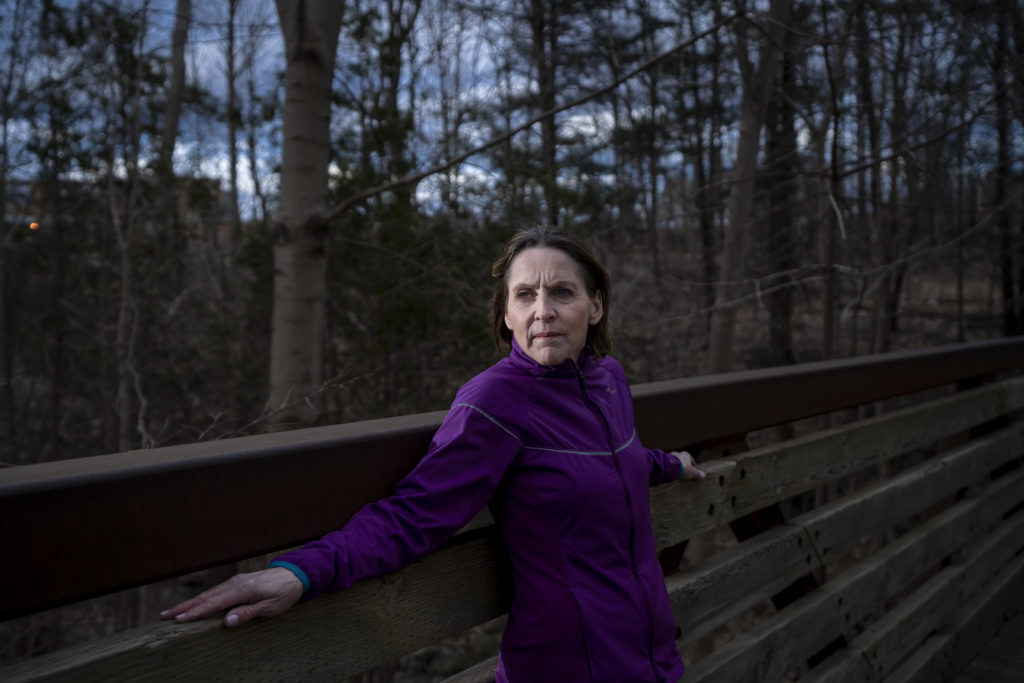
You will encounter what I call “Tunnels of Darkness” moments in the race when you say to yourself “If I feel like this till the end, I don’t think I can go on.”
The truth is, you won’t feel like that till the end. That is why I call them “Tunnels of Darkness.” Just like when you are driving a car, you may go through these periodic tunnels where it seems very dark and you can’t see light. But very soon you see light. The same is true in the run. Just hold on, for 2 minutes, 3 minutes, relax, breath and all of a sudden you come out of that place and you recognize you can go on.
Just because you are running in a new location, nothing has really changed. You have brought the most important thing with you—you.
And all of the strength, courage, perseverance, tenacity, wisdom, strategy, discipline, determination that training built in you, is now what will carry you on these new roads/ new course. Use the new location, encouragement of spectators, other runners running alongside you to help you, encourage you, but remember YOU and everything that has been developed over these months of training is what will allow you to triumph. In my Olympic Race, when it got really tough, I had to remind myself: ” Silvia, you have been here before. Not on the L.A freeway, but on the country concessions, the early mornings, the roads around Newtonville, Guelph, you didn’t quit then, so why would you quit now. Nothing has changed.”
My coach Hugh Cameron gave me some tremendous advice and help advice over the years and one of the things he said to me: “imagine all of the training as deposits put into your bank account and on race day morning go and make a complete withdrawal.”
What makes a marathoner is not the time in which you ran it (though people are always quick to ask “what was your time?”), but what you had to overcome to get to the starting line, and what you had to overcome to finish. There are “handicaps” that each of us overcome on the road to the marathon and in the marathon itself whether it’s injuries we had, time constraints we had, illness, whatever. Being able to overcome any of these and standing on the starting line, is a tremendous feat. I am not sure why time has become such a “measure” for people of success. For me, what we overcome to do the run is what makes a runner.
Give doubts no room to enter. Slam the door on the doubts. I call it combatting doubt with truth. Focus on what is true: “you have what it takes to do this.” There is a proverb that says “life and death are in the power of the tongue.” Even if you just whisper it, mouth it, speak those life words—hope words: “I have what it takes. I will be changed by this experience. I will cross the finish line. I will be an inspiration to my family, children, grandchildren, friends. I am prepared.”
When I was in my Olympic Race, I was becoming SO convinced that I must be slowing down because the lead group I was running with was starting to pull away from me at around the 18-20 mile mark. In looking back at the race splits, I was running consistent splits, the others chose to pick up the pace to try to catch the lead runner Joan Benoit. Although I did not have anything left to pick up the pace, I was NOT slowing down. So others around you may have a different race strategy: do not allow yourself to become discouraged or taken off your plan. They may very well come back to you later in the run.
One of my running hero’s whose running journey was illuminated in the Oscar winning motion picture Chariots of Fire said: “So where does the strength come from to see the race to the end? From within.”
The latest issue of iRun is now available digitally—and print! Yes, that’s right, you can flip through the pages of the issue issue for Silvia Ruegger’s emotional story about the power of the human spirit, the reason why Kevin Rutherford’s stays inspired to put Nuun on the running map, along with stories that focus on the power of the personal connections we have through this sport. Where will you find iRun in print? First, stop by the iRun booth at Ottawa Race Weekend (May 24-May26) and pick up your copy. But even if you’re not in Ottawa, you’ll be able to find the issue at Running Room locations across the country, and other independent running stores including Forerunners in Vancouver, MEC in Victoria and Calgary, Frontrunners in Victoria, Peach City Runners in Penticton, B.C., Gord’s Running Store in Calgary, The Running Factory in Calgary, Running Free in Markham, Ont., Runner’s Den in Hamilton, The Running Works in Guelph, Runner’s Choice in Kingston, Sport X in Smiths Falls, The Running Link in New Liskeard, Black Toe Running, Runner’s Shop and Salomon in Toronto, and Bushtuka in Ottawa. Don’t see your favourite local running store on the list? Let us know and we’ll find a way to make copies available, in the mean time you can read the digital version right now.